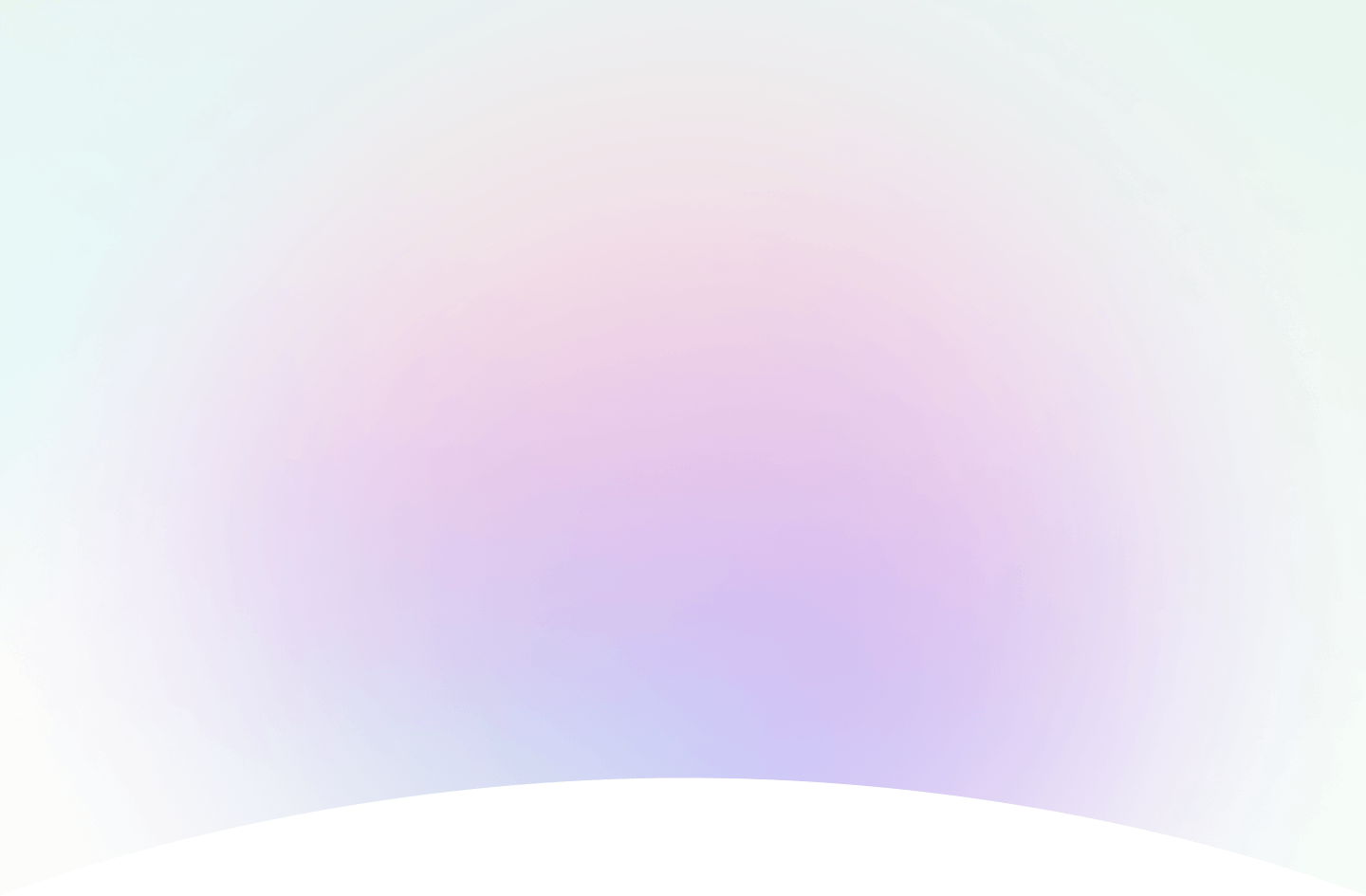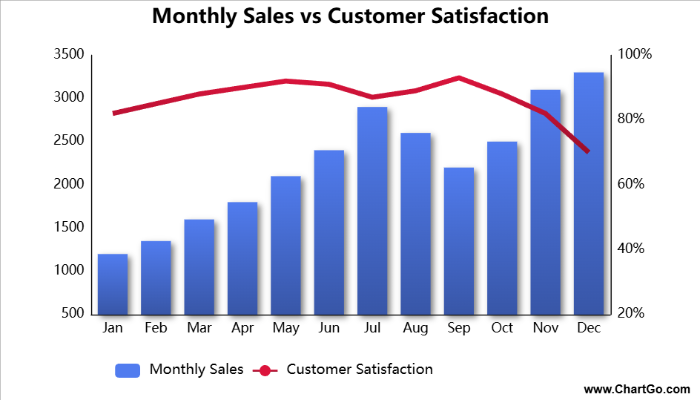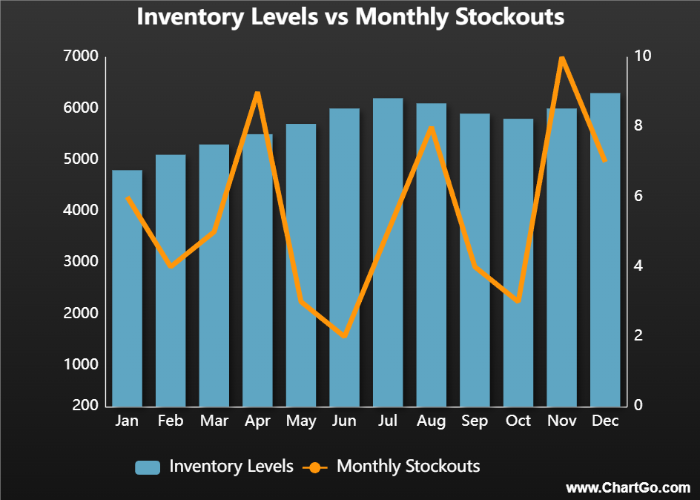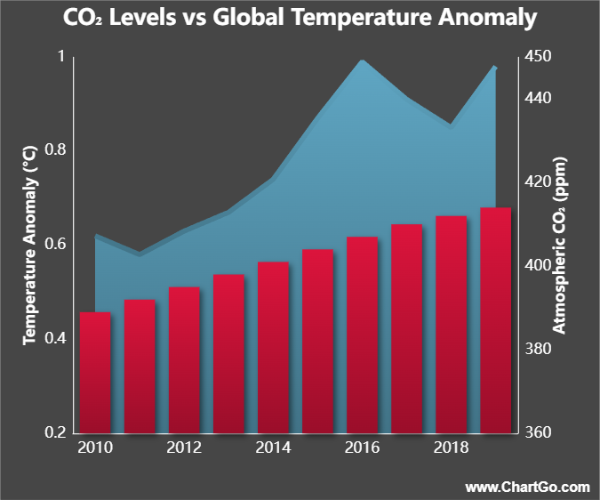
How to Create and Use Combo Charts with Examples
In this guide, we’ll explain what a combo chart is and when combining chart types makes your data clearer. More importantly, we’ll help you create your own combo chart instantly with ChartGo so you can compare different data series on a single, powerful visual. Combo charts let you mix bar, line, and area styles to highlight relationships, contrasts and trends in one place. What insights appear when you combine chart types instead of choosing just one?

What is a Combo Chart?
A combo chart lets you display two different chart types together. Most commonly a bar chart and a line chart. By combining styles, you can compare different kinds of data in one place and highlight contrasts or relationships more clearly.
In simple terms, it's a visual way to show how two related data stories interact. You might track sales using bars while showing growth rate using a line, or compare totals with trends in a single view. Combo charts make complex comparisons feel intuitive and easy to interpret.

Try This Combo Chart Example in ChartGo
Create a New Combo Chart
This combo chart compares monthly sales volume with customer satisfaction scores across the year. The bars show the total number of units sold each month, while the line reveals how customers rated their experience on a scale from 1 to 100. This example highlights a common business pattern: strong sales months do not always correlate with higher satisfaction. Notice how July and November have peak sales but slightly lower satisfaction due to increased demand and strain on customer support. This type of chart is ideal for understanding how operational performance affects customer sentiment over time.
When to Use a Combo Chart
Combo charts are ideal when you want to compare two different types of data on one visual. By combining bar, line, or area series, you can show totals alongside trends, or direct comparisons alongside growth rates.
For example, you might display monthly revenue using bars while overlaying a line that shows year-over-year growth. Or use bars for volume and a line to highlight averages or benchmarks. A combo chart lets you communicate two stories in one clear visual.
Use a combo chart when you want to answer questions like:
- How do actual totals compare to trends or rates?
- Are two related datasets moving together or diverging?
- How does one metric influence or explain another?
- Which visual helps highlight the primary insight, bars or lines?
If your goal is to highlight relationships between datasets or show contrasts more clearly, a combo chart is the best choice. When one chart type alone isn’t enough to tell the full story, a combined approach delivers clarity.
Create and Customize Your Own Combo Chart
Most guides explain what a combo chart is, but with ChartGo you get to build one yourself. Select two different chart types,such as bar and line, adjust the data for each series and watch your combined chart update instantly.
This hands-on approach lets you see how each chart type contributes to the story. Change the Y-axis ranges, add titles, modify intervals, or switch between bar, line, and area styles. Each series has its own settings, so you can match formatting, colours, and scale independently. Whether you’re showing totals with bars and trends with a line, or comparing patterns across two metrics, ChartGo makes combo chart customization quick and intuitive.

Customize Combo Chart Example
Create a New Combo Chart
So don’t just read about combo charts, build and modify them. You’ll quickly see how every small change helps tell a clearer data story.
Examples of Combo Charts in Action
Combo charts combine two visualization styles, such as bars with lines or bars with areas, making them ideal for scientific data where two related measurements move together but on different scales. They’re powerful when you want to compare magnitude (bar) and trend (line or area) in a single view. Here are three scientific examples that demonstrate how combo charts reveal patterns you might otherwise miss.
1. Rainfall vs River Flow Rate
This chart combines monthly rainfall (bars) with river flow rate (line), showing how precipitation
influences water levels throughout the year.
2. Sunlight Hours vs Plant Growth
A combo chart comparing sunlight duration (bars) and average weekly plant growth (line)
over several weeks, perfect for biological or ecological studies.
3. Atmospheric CO₂ vs Global Temperature Anomaly
A bar + area chart showing rising CO₂ levels alongside temperature anomalies
to illustrate long-term climate change patterns.
Rainfall vs River Flow Rate - Combo Chart
By Josie

This scientific combo chart compares monthly rainfall with river flow rate.
Rainfall levels are displayed as bars, while the river’s flow rate is shown as a line.
The combination makes it easy to see how precipitation impacts river behavior
throughout the year.
Sunlight Hours vs Plant Growth – Combo Chart
By Alana

This combo chart compares sunlight hours with weekly plant growth.
Bars show the duration of sunlight exposure, while the line represents average plant growth.
It clearly highlights how biological growth responds to increasing or decreasing light.
CO₂ Levels vs Temperature Anomaly – Combo Chart
By Josie

This combo chart displays atmospheric CO₂ levels alongside global temperature anomalies.
CO₂ is shown as bars, while temperature anomaly is displayed as an area shape.
The pairing reveals long-term climate trends in a clear and compelling format.
Expert Tips from the ChartGo Team
After helping thousands of users build Combo Charts, we’ve learned what makes a mixed chart work and what makes it confusing. Here are a few expert tips to help your combo charts shine:
- Give each chart type a purpose: Use bars to show totals or volume, and lines to highlight trends or rates. When each visual plays a clear role, your message becomes stronger.
- Balance scales carefully: If your two series use different value ranges, adjust the Y-axis settings so both are readable without overwhelming the viewer.
- Use contrast wisely: Combine distinct colours or styles (e.g., solid bars with a bold line) so each series stands out without competing visually.
- Label both axes: With two chart types on screen, clear Y-axis titles, prefixes, and intervals are essential. Good labeling prevents viewers from misinterpreting the data.
- Don’t overload the chart: Two series are usually enough. Adding more types or unrelated metrics can make the chart feel busy and harder to understand.
Remember: A great combo chart tells two connected stories in one visual. With ChartGo, you can fine-tune each series bar, line or area until the relationship between them becomes clear, compelling and easy to understand.